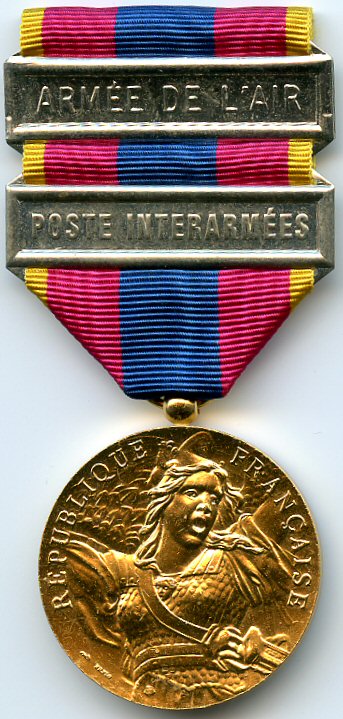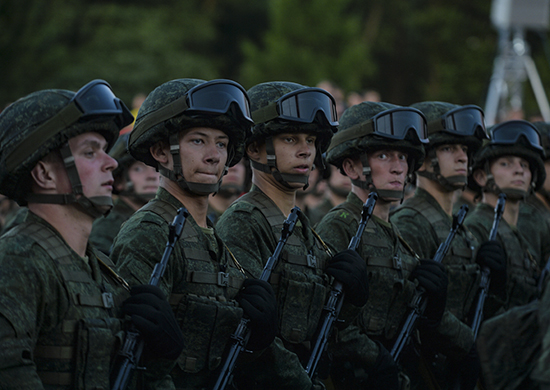|
Médaille Des Services Militaires Volontaires
The Medal for voluntary military service (french: "Médaille des services militaires volontaires") is a French military decoration established on 13 March 1975 by decree 75-150. It was established in three grades to recognize voluntary military service in the reserves. During World War I, the reserves served as an important part of the defence of France. Following the end of hostilities, in order to reward their volunteerism during training periods, a decree of 13 May 1934 created the "Cross for voluntary military service" (french: "Croix des services militaires volontaires") in three grades, bronze, silver and gold. This first incarnation of a truly reserve award was rather short lived being replaced on 22 March 1957 with the "Order of military merit" (french: "Ordre du mérite militaire") at the request of the "Union Nationale des Officiers de Réserve" ( en, "National Union of Reserve Officers"). This award, like many other French orders, had three grades Knight, Officer, and C ... [...More Info...] [...Related Items...] OR: [Wikipedia] [Google] [Baidu] |
National Defence Medal
The National Defence Medal (french: "Médaille de la Défense nationale") is a French military decoration. It was created by Charles Hernu, Minister of Defence and established by decree on 21 April 1982. It rewards particularly honourable service rendered by military personnel for their participation in operational activities. The medal has three levels: Gold, Silver and Bronze. Eligibility For military service The award is made by decision of the military hierarchy, but the recipients must have achieved a personal minimum of: * For the Bronze level: 1 year of service and accumulated 90 points; * For the Silver level: 5 years of service (minimum 2 years in the Bronze level) and accumulated 600 points; * For the Gold level: 10 years of service (minimum 2 years in the Silver grade) and accumulated 800 points The yearly quota of Gold and Silver level awards are set by the minister of defence. Points are earned through participation in exercises, operations, proficiency, initiative, ... [...More Info...] [...Related Items...] OR: [Wikipedia] [Google] [Baidu] |
Marianne
Marianne () has been the national personification of the French Republic since the French Revolution, as a personification of liberty, equality, fraternity and reason, as well as a portrayal of the Goddess of Liberty. Marianne is displayed in many places in France and holds a place of honour in town halls and law courts. She is depicted in the ''Triumph of the Republic'', a bronze sculpture overlooking the Place de la Nation in Paris, as well as represented with another Parisian statue on the Place de la République. Her profile stands out on the official government logo of the country, appears on French euro coins and on French postage stamps. She was also featured on the former franc currency and is officially used on most government documents. Marianne is a significant republican symbol; her French monarchist equivalent is often Joan of Arc. As a national icon Marianne represents opposition to monarchy and the championship of freedom and democracy against all forms of ... [...More Info...] [...Related Items...] OR: [Wikipedia] [Google] [Baidu] |
French Armed Forces
The French Armed Forces (french: Forces armées françaises) encompass the Army, the Navy, the Air and Space Force and the Gendarmerie of the French Republic. The President of France heads the armed forces as Chief of the Armed Forces. France has the sixth largest defence budget in the world and the first in the European Union (EU). It has the largest armed forces in size in the European Union. According to Credit Suisse, the French Armed Forces are ranked as the world's sixth-most powerful military. History The military history of France encompasses an immense panorama of conflicts and struggles extending for more than 2,000 years across areas, including modern France, greater Europe, and French territorial possessions overseas. According to British historian Niall Ferguson, the French participated in 50 of the 125 major European wars that have been fought since 1495; more than any other European state. They are followed by the Austrians who fought in 47 of them, the ... [...More Info...] [...Related Items...] OR: [Wikipedia] [Google] [Baidu] |
Military Reserve Force
A military reserve force is a military organization whose members have military and civilian occupations. They are not normally kept under arms, and their main role is to be available when their military requires additional manpower. Reserve forces are generally considered part of a permanent standing body of armed forces, and allow a nation to reduce its peacetime military expenditures and maintain a force prepared for war. In countries with a volunteer military, such as Canada, Spain, the United States and the United Kingdom, reserve forces are civilians who maintain military skills by training periodically (typically one weekend per month). They may do so as individuals or as members of standing reserve regiments—for example, the UK's Army Reserve (United Kingdom), Army Reserve. A militia, home guard, State defense force, state guard or state military may constitute part of a military reserve force, such as the National Guard (United States), United States National Guard a ... [...More Info...] [...Related Items...] OR: [Wikipedia] [Google] [Baidu] |
Obverse
Obverse and its opposite, reverse, refer to the two flat faces of coins and some other two-sided objects, including paper money, flags, seals, medals, drawings, old master prints and other works of art, and printed fabrics. In this usage, ''obverse'' means the front face of the object and ''reverse'' means the back face. The obverse of a coin is commonly called ''heads'', because it often depicts the head of a prominent person, and the reverse ''tails''. In numismatics, the abbreviation ''obv.'' is used for ''obverse'',David Sear. ''Greek Imperial Coins and Their Values.'' Spink Books, 1982. p. xxxv. while ℞, )(Jonathan Edwards. ''Catalogue of the Greek and Roman Coins in the Numismatic Collection of Yale College, Volume 2.'' Tuttle, Morehouse & Taylor, 1880. p. 228. and rev.Allen G. Berman. ''Warman's Coins And Paper Money: Identification and Price Guide.'' Penguin, 2008. are used for reverse. In fields of scholarship outside numismatics, the term ''front'' is more commo ... [...More Info...] [...Related Items...] OR: [Wikipedia] [Google] [Baidu] |
Defence And Internal Security Volunteer Reservists Medal
The Defence and Internal Security Volunteer Reservists Medal (french: Médaille des réservistes volontaires de défense et de sécurité intérieure) is a civil and military service medal of France. Established on 1 July 2019, it replaces the Medal for voluntary military service. Establishment Created by Decree No. 2019-688 of 1 July 2019, the Defence and Internal Security Volunteer Reservists Medal is awarded for loyalty and commitment to service performed in the military operational reserve, National Police reserve, the Defense and security citizen reserve, and the National Police citizen reserve. The medal may also be awarded to people working for the benefit of reservists or to those who promote the mission of the volunteer reservists. This medal was created to replace the Medal for voluntary military service. Recipients of the Medal for voluntary military service may continue to wear it. Individuals may not wear it if they have been awarded the Defence and Internal Sec ... [...More Info...] [...Related Items...] OR: [Wikipedia] [Google] [Baidu] |



